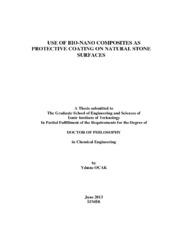Please use this identifier to cite or link to this item:
https://hdl.handle.net/11147/2957Full metadata record
| DC Field | Value | Language |
|---|---|---|
| dc.contributor.advisor | Sofuoğlu, Aysun | en |
| dc.contributor.author | Ocak, Yılmaz | - |
| dc.date.accessioned | 2014-07-22T13:48:39Z | - |
| dc.date.available | 2014-07-22T13:48:39Z | - |
| dc.date.issued | 2013 | en |
| dc.identifier.uri | http://hdl.handle.net/11147/2957 | - |
| dc.description | Thesis (Doctoral)--Izmir Institute of Technology, Chemical Engineering, Izmir, 2013 | en |
| dc.description | Includes bibliographical references (leaves: 112-121) | en |
| dc.description | Text in English; Abstract: Turkish and English | en |
| dc.description | xiv, 121 leaves | en |
| dc.description.abstract | Historical monuments are important heritages to pass cultural values to next generations. Most of the historical monuments were composed of natural stones like marble. SO2 and NOx reacts with marble composed primarily of calcite (CaCO3) is a dry deposition process, gypsum (CaSO4.2H2O) and nitrocalcite (Ca(NO3)2.4H2O) are formed after reaction. The polylactic acid (PLA), 2, 5 and 7 wt.% montmorillonite (MMT) clay added PLA (PLA/MMT2, PLA/MMT5 and PLA/MMT7) bio-nano composites coated and uncoated surfaces were tested for capillary water absorption, water vapor permeability, color alteration, and surface hydrophobicity regarding the nanofiller concentrations before reaction. Results indicated that the bio-nano composite coatings didn’t alter the color of the marble, improved the hydrophobicity and barrier properties of the marbles. The level of layered silicate delamination in the PLA matrix and structural characterizations of PLA nanocomposite coatings were affected the barrier properties of the composites coatings. The X-ray diffraction (XRD), atomic force microscopy (AFM) and scanning transmission electron microscopy (STEM) analysis pointed out that 5% layered silicates were homogenously dispersed in the polymer matrix, exfoliated structures also were observed in some parts of the polymer matrix and nano particles enhanced the nano-composite coating barrier performance. The protection capabilities of the bio-nano composite coatings were studied in laboratory setup (include nearly 8 ppm SO2) and ambient city atmosphere (include nearly 8 ppb SO2 and 64 ppb NO2). The PLAMMT5 bio-nano composite showed significant reduction (~5 times) in the crust formation after 180 days SO2-calcite reaction in laboratory and 9-10 times after 20 months ambient city exposures for outdoor conditions. Bio-nano composites also decreased the kinetic parameters such as rate constant (ks) and effective diffusivity (De) values of the marbles. These results indicated that PLA/MMT bio-nano composite coating seems to be significant promising materials as protective coating agents in reducing the effects of atmospheric pollutants on the marble surfaces. | en |
| dc.language.iso | en | en_US |
| dc.publisher | Izmir Institute of Technology | en |
| dc.rights | info:eu-repo/semantics/openAccess | en_US |
| dc.subject.lcsh | Monuments--Conservation and restoration | en |
| dc.subject.lcsh | Nanocomposites (Materials) | en |
| dc.subject.lcsh | Protective coatings | en |
| dc.title | Use of bio-nano composites as protective coating on natural stone surfaces | en_US |
| dc.type | Doctoral Thesis | en_US |
| dc.institutionauthor | Ocak, Yılmaz | - |
| dc.department | Thesis (Doctoral)--İzmir Institute of Technology, Chemical Engineering | en_US |
| dc.relation.publicationcategory | Tez | en_US |
| item.languageiso639-1 | en | - |
| item.fulltext | With Fulltext | - |
| item.openairecristype | http://purl.org/coar/resource_type/c_18cf | - |
| item.openairetype | Doctoral Thesis | - |
| item.grantfulltext | open | - |
| item.cerifentitytype | Publications | - |
| Appears in Collections: | Phd Degree / Doktora | |
Files in This Item:
| File | Description | Size | Format | |
|---|---|---|---|---|
| 10011170.pdf | DoctoralThesis | 8.66 MB | Adobe PDF |  View/Open |
CORE Recommender
Page view(s)
110
checked on Jul 22, 2024
Download(s)
172
checked on Jul 22, 2024
Google ScholarTM
Check
Items in GCRIS Repository are protected by copyright, with all rights reserved, unless otherwise indicated.